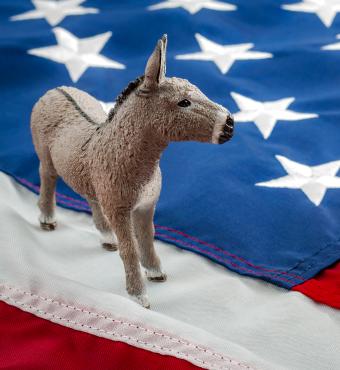- History
- US
- Politics, Institutions, and Public Opinion
- Campaigns & Elections
- State & Local
- California
There’s something about close elections and unexpected results that breeds conspiracy theories.
For example, the 1960 presidential election: Nixon acolytes (and Kennedy haters, for that matter) won’t let go of the notion that Illinois was stolen from the Republican column.
Similarly, for the past two years, tinfoil-hat Democrats keep looking for proof that the Trump presidency is a byproduct of Russian collusion rather than Hillary Clinton’s ineptitude in Michigan, Pennsylvania, and Wisconsin.
Apparently, tinfoil is what passes for California chic these days, what with some Republicans convinced that the party’s thrashing at the congressional level—seven seats lost, reducing by half the state’s GOP House delegation—was an inside job.
Granted, what’s happened in California is an eye-opener. When the polls closed in America’s nation-state on election night, Republican candidates led in six of the seven House seats that Democrats coveted.
But the votes kept tumbling in—an additional five million ballots, or about 40 percent of the overall vote total.
And that surge? They turned all seven red seats blue. When the new Congress convenes in January, 46 of the 235 House Democratic seats will come from California—almost one-fifth the majority caucus. California Republicans will account for 7 of the 200 seats on the minority side—that is, 1 in every 28.5 GOP seats in the House of Representatives.
Here’s how startling the post-election vote shift in the Golden State was. In the non-incumbent contest in California’s 39th Congressional District, Republican Young Kim enjoyed a modest lead on election night. However, Democrat Gil Cisneros earned 56 percent of the “overtime” ballots, turning an 8,000-vote deficit into a 7,600-vote advantage. He’ll be going to Washington, not Kim.
The swing was even more dramatic in California’s 45th Congressional District. There, two-term GOP Representative Mimi Walters had a 6,200-vote lead on election night. At last glance (and these numbers keep bouncing as the vote count rises), she trails by nearly 12,600 ballots.
The question—and the reason some California Republicans are playing the conspiracy card: Are such vote swings the result of one party being better organized than its rival, or did Democrats engage in some political chicanery?
Specifically, did Democrats steal a few House elections via what’s called “ballot harvesting”—a practice in which third parties collect and turn in completed ballots?
Actually, “steal” is the wrong verb in this case. Unlike most states, ballot harvesting is permissible in the Golden State, thanks to this law approved two years ago by the Democratic-controlled State Legislature and signed by outgoing Governor Jerry Brown, also a Democrat.
In principle, there’s nothing wrong with party activists going door to door, and block to block, collecting ballots not theirs. Some might call that neighborly—even civic-minded. The line could be crossed, though, if the aforementioned do-gooder engages in bribery or coercion—or plain old fraud (most likely, forging a ballot)—in order to get that vote recorded.
The challenge for California Republicans is, first, proving that “harvesting” was conducted illegally—and, after that, providing evidence that enough votes were obtained illegally to swing an election.
That challenge doesn’t mean there’s no need to peek behind the wizard’s curtain. There is a legitimate conversation to be had in California with regard to the sanctity of the democratic process. And it began, oddly enough, on the other side of the country when House Speaker Paul Ryan employed the word “bizarre” to characterize California’s election results.
California Secretary of State Alex Padilla, who oversees Golden State elections, fired back at the Speaker (“it is bizarre that Paul Ryan cannot grasp basic voting rights protections”).
About Secretary Padilla: it’s his job to defend the current process. He’s also a former state senator and Democratic activist who’s mentioned as a possible successor to Senator Dianne Feinstein (Jerry Brown served one term as secretary of state before his first gubernatorial run in 1974). If the current system works to his party’s benefit, I’m not sure that Secretary Padilla’s willing to engage in a conversation about potential design flaws.
In a better world, the State Legislature would hold hearings next year to discuss election integrity. A good starting point: If it takes weeks, not hours, to count ballots, what happens in 2020 when the Golden State holds an early presidential primary?
What else could the Legislature examine? Bre Payton, writing for The Federalist, offers a good shopping list: a “motor voter” program that’s resulted in tens of thousands of erroneous voter registrations;
provisional voting that allows Californians to participate even if their name isn’t on the official registration list at the voting place; counties shifting to vote-by-mail only and “one-stop vote centers.” I’d add one more: “conditional” voter registration that allows residents to participate if they missed the last registration deadline (in California, that was October 22).
Perhaps such a vetting would curtail the “we wuz robbed” talk coming from the losing side.
Then again, California Republicans need to look at the big picture.
In 2018, Democrats organized and spent in the Golden State in ways not seen in previous midterm elections.
Second, California House Republicans were dealt an especially weak hand: an unpopular GOP president; a signature accomplishment (the Trump tax cut) that’s a difficult sell to many California taxpayers; in some districts, incumbents who retired or whose political freshness had long expired.
Questioning an election’s integrity may feel good for the truest of believers—cathartic, for some, and cheaper than seeing a therapist. But it’s not a strategy for getting a party back in the business of winning election. Such is the challenge for Democrats in 2020: putting aside their animus for Trump and focusing instead on how to regain the trust of blue-collar Middle America.
That’s the same challenge for California Republicans moving forward.
For them, the 2018 election was lost in the likes of Orange County, where GOP candidates struggled with suburban female, educated voters, as the party did nationwide. Republican candidates yet again struggled to gain footholds in the populous expanses of Los Angeles and the San Francisco Bay Area counties. In four top-of-the ballot statewide races, GOP alternatives failed to crack 40 percent of the vote—the number considered the political equivalent of baseball’s “Mendoza Line” for batting futility.
Those are facts, not allegations.
Uneasy lies the head that wears a tinfoil hat.
















